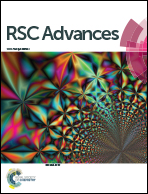Starch assisted palladium(0) nanoparticles as in situ generated catalysts for room temperature Suzuki–Miyaura reactions in water†
Abstract
A simple and efficient methodology for the in situ generation of Pd-nanoparticles in the presence of starch and NaOH at room temperature has been developed. It has been observed that starch played a dual role in controlling the reduction rate of metal ions and the aggregation process of metal atoms in solution. The in situ generated Pd-nanoparticles show excellent catalytic activity in the Suzuki–Miyaura cross coupling reaction of electronically diversified arylbromides and arylboronic acids in pure water at room temperature with low catalyst loading.


 Please wait while we load your content...
Please wait while we load your content...